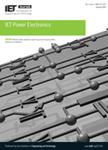版权所有:内蒙古大学图书馆 技术提供:维普资讯• 智图
内蒙古自治区呼和浩特市赛罕区大学西街235号 邮编: 010021

作者机构:China Univ Petr East China Coll Informat & Control Engn 66 West Changjiang Rd Qingdao 266580 Peoples R China China Inst Atom Energy Beijing 102413 Peoples R China
出 版 物:《IET POWER ELECTRONICS》 (IET Power Electron.)
年 卷 期:2018年第11卷第14期
页 面:2338-2345页
核心收录:
基 金:Fundamental Research Funds for the Central Universities [18CX02114A] National Natural Science Foundation of China
主 题:inductors zero voltage switching resonant power convertors zero current switching pulse frequency modulation pulse width modulation adaptive control load regulation optimisation control system synthesis self-adaptation load change control strategy pulse-frequency modulation symmetrical pulse-width modulation burst load-independent point switching conditions resonant inductance resonant frequency high frequency band no-load conditions light load condition three-phase staggered parallel LLC resonant converter gain curve resonant current adaptive load change control strategy design control strategies optimisation excitation inductor output voltage soft-switching state experimental prototype SiC devices
摘 要:The resonant frequency of LLC resonant converter has a wide range of switching frequency due to load changes and it easily enters high frequency band during light load and no-load conditions. Therefore, this study proposes a self-adaptation load change control strategy. According to different load conditions, the converter automatically selects the best control mode among three control methods, which are pulse-frequency modulation, symmetrical pulse-width modulation and burst. By fully utilising the characteristics of the load-independent point in the gain curve and the relationship between the resonant current and the load, the switching conditions between the control strategies are further designed and optimised. In addition, based on the adaptive load change control strategy, the design value of k (the ratio of the excitation inductor to the resonant inductance of the transformer) is increased, which solved the disadvantage of large change of the switch range. And the converter can not only effectively control the output voltage during light load, but also works in the soft-switching state, which can improve the working efficiency of the converter to above 91%. Finally, taking a three-phase staggered parallel LLC resonant converter as the research object, an experimental prototype was developed based on SiC devices to verify the correctness and rationality of the proposed control strategy.